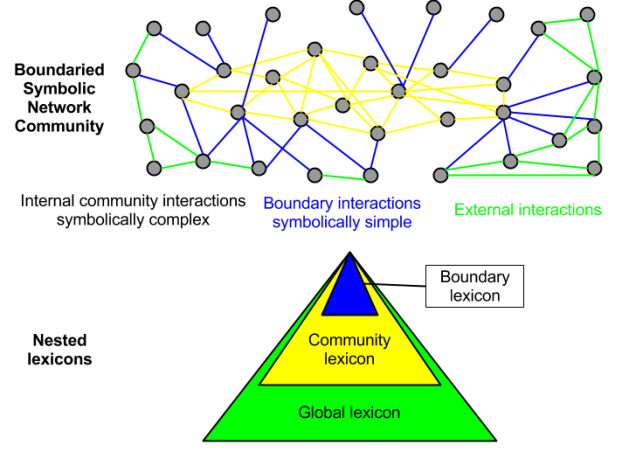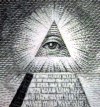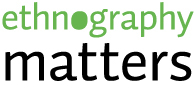Why Weird Twitter
Editor’s Note: Sebastian Benthall (@sbenthall) is a PhD student at the UC Berkeley School of Information who studies collective intelligence, economics of data and information, and other monsters. In this post for our Virtual Identity edition, he writes about community identity/identification, attention economy, and Weird Twitter.
(slider image: Bird’s Eye View by Mozzercork)
___________________________________________________________
tl;dr There’s no such thing as Weird Twitter
Will there be a mythology in the future, they used to ask, after all has become science? Will high deeds be told in epic, or only in computer code?
And after the questing spirit had gone into overdrive during the early Space Decades, after the great Captains had appeared, there did grow up a mythos through which to view the deeds. This myth filter was necessary. The ship logs could not tell it rightly nor could any flatfooted prose. And the deeds were too bright to be viewed direct. They could only be sung by a bard gone blind from viewing suns that were suns.
— R.A. Lafferty, Space Chantey
Imagine that there is a community or culture of people that use social media–let’s focus on Twitter–in a particularly interesting or funny or outlandish way. Would you give it a name? Would you try to understand its size or its structure? Its history? Its purpose? How would you go about doing that?
Could it be studied by an anthropologist? A data scientist? An economist? A philosopher? A critic? A journalist? Could it ever understand itself?
I’m getting ahead of myself. Let’s start with a name: Weird Twitter.
Traces
This is a Google Trends query for the string “weird twitter”.

There have been two spikes in search popularity of “weird twitter” in the past year. The second spike corresponds to the publication of the brilliant “Weird Twitter: The Oral History“, by Herrman and Notopoulos, (BuzzFeed, April 2013). The authors explain:
Weird Twitter is vast and amorphous; what it looks like depends hugely on whom you follow, when you followed them, and what you find funny. … Some of its best writers have a few hundred followers, while others have tens of thousands. Styles of tweeting and types of jokes that originated among its small sects have bled out into the mainstream: Even to comedians, these are some of the funniest people on Twitter.
The first spike in October 2012, which marks the beginning of a consistent hum of search activity for “weird twitter”, coincides with this tweet by erstwhile pseudonymous Gawker writer Mebute Sese Seko.
Thank you for ruining everything, nerds. http://t.co/cfhL0ZjX http://t.co/QCBDeanh
— Jeb Lund (@Mobute) October 17, 2012
At the time, Mebuto Sese Seko had almost 10,000 followers. This tweet triggered a series of events that lead to the wider adoption of the term.
Notably, Mebuto didn’t use the phrase “weird twitter” himself, and he linked to screenshots, not to web pages. The second image was of an anonymous Quora post that identified Weird Twitter as Twitter’s equivalent of 4chan’s /b/, or “Random”, subcommunity. The first image pictured a blog post I had written the previous summer.
Boundaried symbolic network community
A lot was going through my head when I wrote that blog post. In the Spring of 2012 I was reading Anthony Cohen‘s work on the symbolic construction of community. For Cohen, a community is constituted by its creation and use of symbols. Especially critical for the community’s identity are the symbols it uses to mark its boundary–members and non-members. I was also reading Caroline Haythornthwaithe‘s work on Social Networks and On-line Community, which emphasizes the topological structure of on-line social networks over symbolic meaning-making.

(I did this preliminary work in on-line community detection in collaboration with a classmate, Dave Tomcik.)
At the same time I was following a few of what now would be called Weird Twitter accounts. It got me thinking: most work on virtual communities in cyberspace depends on technical infrastructure to provide the community boundaries. A mailing list is a community circumscribed by the technicalities of mailing list membership. A web service like Reddit supports multiple communities by supporting multiple distinct subreddits. But Twitter supports the growth of an ad hoc network structure without distinct watering holes demarcated in the user interface.
How could one identify a community within such a social network? I had a hunch that these networks, which would depend on the organic social connections between individuals and not the commercially built and sustained technical environment, would be special.

What sort of digital signature would such a community show? According to my reading of Cohen, it would be involved in vigorous, complex dialog about, among other things, what symbols to use to represent itself. Since the digital environment is one in which symbols (e.g. words) are constantly flying around and being recorded, I thought this kind of community could be algorithmically detected. Which I find both thrilling and chilling. Eric Snowden’s recent whistleblowing has let America know its on-line activity is under state surveillance all the time, on top of the surveillance by commercial interests.
Chaotic resistance
 I believe we have an opportunity to use the wealth of data available now to really advance social science. But the reality is our research will, if successful, be used for political manipulation, commercial advertising, and other kinds of social manipulation and control. For me, this makes it imperative that I present my research to the public. If I work on methods for on-line community detection, I should try to make those insights usable by communities to understand themselves and evade detection if they desire.
I believe we have an opportunity to use the wealth of data available now to really advance social science. But the reality is our research will, if successful, be used for political manipulation, commercial advertising, and other kinds of social manipulation and control. For me, this makes it imperative that I present my research to the public. If I work on methods for on-line community detection, I should try to make those insights usable by communities to understand themselves and evade detection if they desire.
Most rhetoric about evading on-line detection is about making less information available. That makes sense for the individual. But in aggregate, this cleans the data set, making it easier to find patterns that haven’t been self-censored away.
The biggest challenges to behavioral data scientists are not the availability of data, but data’s complexity. If data has a high Kolmogorov complexity and perhaps logical depth, it will be very difficult to extract patterns from.
In other words: you cannot master noise and chaos. It is the abyss staring back. Much as Dadaism was a tool for eroding the establishment and Situationists sought to challenge society through liberated, authentic expression, social media users can resist surveillance by making their interactions more wild, original and complex. Big Brother is watching, but he can be blinded by confusion fu.
 I thought I had found a nexus of this kind of noisy on-line behavior on Twitter. If what I was seeing was a community at all, it was a community of chaos and exploration. And it knew it. I had read the term “weird twitter” in @regisl‘s tweets in March 2012 when he was writing a lot of exploratory, reflective thoughts on Twitter culture. His and others insights into virtual community were profound, echoes of some of the earliest musings on virtual community, such as by Electronic Frontier Foundation founder John Perry Barlow in “Crime and Puzzlement” (1990):
I thought I had found a nexus of this kind of noisy on-line behavior on Twitter. If what I was seeing was a community at all, it was a community of chaos and exploration. And it knew it. I had read the term “weird twitter” in @regisl‘s tweets in March 2012 when he was writing a lot of exploratory, reflective thoughts on Twitter culture. His and others insights into virtual community were profound, echoes of some of the earliest musings on virtual community, such as by Electronic Frontier Foundation founder John Perry Barlow in “Crime and Puzzlement” (1990):
As a result of [the opening of Cyberspace], humanity is now undergoing the most profound transformation of its history. Coming into the Virtual World, we inhabit Information. Indeed, we become Information. Thought is embodied and the Flesh is made Word. It’s weird as hell.
I figured that holding a mirror up to the noise, crudely describing and interpreting practices that could not be interpreted or described, could only make the chaotic system more complex. At the same time, it would be a test of Cohen’s theory of the symbolic construction of communities in an on-line context: what happens when a community confronts a symbol, in this case the string “Weird Twitter”, that purports to mark its boundary?
Stuart Geiger had introduced me to M.C. Burton’s idea that “trolling is the new critique.” I was interested in trolling as an experimental method. A grown-up Internet kid who had done and been dished his share of trolling, I figured it was time to put those skills to good use: clumsy live field notes.

According to the Encyclopedia Dramatica, this kind of trolling is a Philosopher Attack (“a type of flame war
where a terminally bored, yet well educated person or group ambush an innocent bystander or group, who were just minding their own business”). I posted in August. Nothing happened.
Then Jeb Lund tweeted about it.







Recent Comments